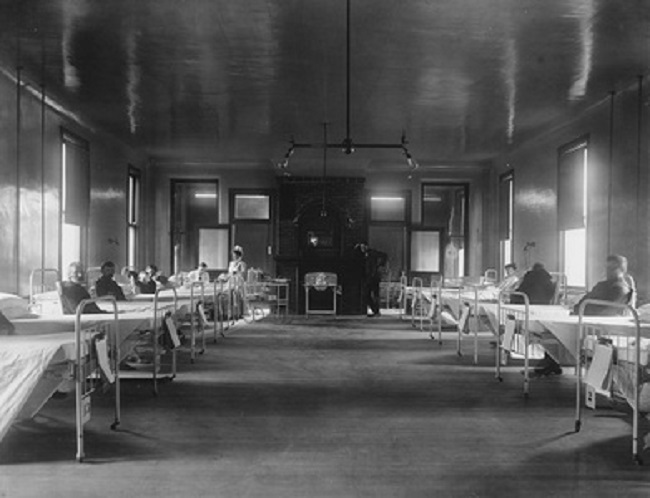When I was a newly graduated resident in my teaching hospital in England, I encountered a case that was so dramatic that I have never forgotten the slightest detail. It probably was my very first introduction to the concept that I came to understand as the all-consuming dominance of the brain over the body. The patient was probably in his late 50s or early 60s and was known to have chronic tuberculosis. One night I had to admit him to the hospital with an acute attack of pneumonia, obviously much more dangerous because of the tuberculosis. This was before the days of antibiotics. In fact we only had the very earliest sulfonamide that existed under a code name of M and B 693. The sulfonamides were eventually displaced by the discovery of penicillin that led to the antibiotic era. A sulfonamide had limited powers at the best and was totally useless in this case.
Hospital Wards
In order to describe my experience, I have to describe how patients were admitted to the hospital. There were no private rooms as we have them today. A man was admitted to a male ward and a woman to a female ward. A ward consisted of about 24-28 beds. There was a partition down the center of the ward and the beds were arranged in two rows of six or seven on each side of the partition. The only privacy that the patient could get was a curtain that ran on a rail around each bed. Each ward was presided over by a head nurse who was called Sister. She wore a uniform that distinguished her from the rest of the nurses, including a specialized cap that was derived from the hood worn by lay sisters in the days when the monasteries were the hospitals. The lay sisters were the nurses and the monks were the doctors.
The Dying Patient
On the morning after this patient had been admitted, I was awaiting the arrival of my chief. In those days a chief was virtually a god to a young resident lucky enough to obtain a job under his skilled care. I was standing by the desk that was used by the Sister in the forefront of the ward when I heard my chief, who had quietly entered the ward behind me, say “I see you have a dying patient, Lonsdale”. I respectfully said “How do you know that Sir?” He went on to explain: pointing at my patient, “Notice how that gentleman is picking at the bedclothes with his fingers. Sometimes he picks at thin air. That is evidence for a sick brain and he will die”.
Well, of course he did die and the autopsy not only revealed the presence of tuberculosis and pneumonia, but the entire body and brain were infiltrated with micro-abscesses filled with staphylococcal pus. In the short time that he survived under our care, he never showed any elevation of body temperature, no increase in circulating white blood cells and in fact no laboratory data that was out of the normal range. If I had shown the data to a colleague without telling him the history and asked him to tell me what was wrong with the patient, he would have said that it was a normal laboratory result and therefore no disease. It was my introduction to the basic fact that the brain is the master organ. It is responsible for directing all the mechanisms that the body uses in responding to the attack imposed by an infectious microorganism. This man’s brain was so near death that it could not direct and organize bodily defenses. The useless action of “picking at thin air” was merely automation of action conducted by a sick brain. The reason for this repetitive format of action in similar cases, easily recognized by my chief, is unknown.
Chronic Infection, Poverty, and Malnutrition
Chronic tuberculosis is commonest in impoverished people with inadequate shelter and nutrition, unfortunately all too common in London at that time. This patient’s immunity, his ability to defend himself from infection, had been wrecked, permitting an onslaught of pneumonia and a death dealing staphylococcal infection. What impressed me so much was that this was defined as a sick brain, not a sick body. It was my initiation into an understanding that it is the brain that organizes defense against infections and indeed virtually any form of stress that forces us to adapt. The body is a living framework, a chassis that transports our brains, relying on a continuous brain/body dialogue that enables us to survive in a hostile environment.
Another Sick Brain
A few years after this, I was in practice in a Midland city called Leicester. One evening at the end of office hours, two young women came into my office and said “We want you to come and see dad”. When I asked what was the problem they said that he had had a cough for about 10 days. I suggested that he could wait until the following day but they insisted on an emergency house call. When I entered the house and climbed the stairs I was confronted by a middle-aged man who was kneeling on all fours on a bed under an un-shaded blue light and “picking at thin air”. He was admitted to hospital and found to have meningitis, caused by a pneumococcus, a bacterium that usually results in pneumonia. The 10 day old cough probably represented a pneumococcal infection of the lung that had spread to the meninges and caused meningitis. Like the patient described above, his sick brain killed him. I came to understand that an infection is an attacking agent, perhaps testing our right to survival. Mother Nature is simply asking us whether we are fit enough to procreate and support the survival of the species, a Darwinian concept. The phenomena that follow are the defenses going into action, a battle organized and conducted by the brain.
The Fortress Analogy
Although I have used this analogy in a previous post, it bears repeating because it illustrates the all important dominance of the brain over the body. The commander of a fortress is in a central location. Soldiers, placed on the battlements, have to spot an approaching enemy. A message is sent to the commander who must then organize the defense. If he is asleep, drunk or otherwise unable to respond, the defenses are never initiated and the fortress conquered. After it has perceived that an infecting organism has started an attack, the brain has this function over the body. Acting as commander, it raises the temperature of the body. This is because attacking micro organisms are programmed to operate at 37°C, the normal temperature of the human body. Raising the body temperature works against the efficiency, or virulence, of the infecting organism. White blood cells are the equivalent of soldiers in the fortress and messages from the brain cause them to pour out from the storage organs, increasing in number as they circulate in the blood. Lymph glands may swell because they act as traps for the organisms. Indeed, all the phenomena that we call illness really represent the complex defense systems going into action. To reduce the fever with medication like aspirin is to increase the risk of defeat by the organism. Every infection represents attack and defense. There are only three possible outcomes, a complete restitution of health, death, or a stalemate where the “battle” continues on an indefinite basis without resolution. Many organisms, known as opportunists, become aware that the defenses of the body are weak or broken. They seek their “opportunity” for winning the battle. Yeast (Candida albicans) is a well known opportunist organism and explains why this infection is so common in people who have a poor defensive program. Children with autism are good examples.
The Secret is Oxidative Metabolism in the Brain
The only way to maintain oxidative efficiency, particularly in the brain where oxygen utilization is maximal, is to eat the healthiest diet available. The noncaloric vitamins and essential minerals are vitally important and are becoming progressively insufficient in the everyday Western diet. Indeed, this seems to be so common that I visualize their supplementation as a necessity to maintain health. There can be no cutting of corners in a world where civilization is an absurd form of continuous stress. Our environment is hostile in many different ways. Assuming that the “fortress” is well-built, it is the “commander” that decides the issues as they face us on a day-to-day basis. All that the “commander” requires is energy and whether we like it or not, this has to come from ideal nutrition.
We Need Your Help
Hormones Matter needs funding now. Our research funding was cut recently and because of our commitment to independent health research and journalism unbiased by commercial interests we allow minimal advertising on the site. That means all funding must come from you, our readers. Don’t let Hormones Matter die.
Yes, I’d like to support Hormones Matter.
This article was published originally on Hormones Matter on May 9, 2016.











